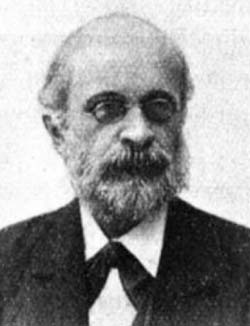

تاريخ الرياضيات

الاعداد و نظريتها

تاريخ التحليل

تار يخ الجبر

الهندسة و التبلوجي


الرياضيات في الحضارات المختلفة

العربية

اليونانية

البابلية

الصينية

المايا

المصرية

الهندية


الرياضيات المتقطعة

المنطق

اسس الرياضيات

فلسفة الرياضيات

مواضيع عامة في المنطق


الجبر

الجبر الخطي

الجبر المجرد

الجبر البولياني

مواضيع عامة في الجبر

الضبابية

نظرية المجموعات

نظرية الزمر

نظرية الحلقات والحقول

نظرية الاعداد

نظرية الفئات

حساب المتجهات

المتتاليات-المتسلسلات

المصفوفات و نظريتها

المثلثات


الهندسة

الهندسة المستوية

الهندسة غير المستوية

مواضيع عامة في الهندسة

التفاضل و التكامل


المعادلات التفاضلية و التكاملية

معادلات تفاضلية

معادلات تكاملية

مواضيع عامة في المعادلات


التحليل

التحليل العددي

التحليل العقدي

التحليل الدالي

مواضيع عامة في التحليل

التحليل الحقيقي

التبلوجيا

نظرية الالعاب

الاحتمالات و الاحصاء

نظرية التحكم

بحوث العمليات

نظرية الكم

الشفرات

الرياضيات التطبيقية

نظريات ومبرهنات


علماء الرياضيات

500AD

500-1499

1000to1499

1500to1599

1600to1649

1650to1699

1700to1749

1750to1779

1780to1799

1800to1819

1820to1829

1830to1839

1840to1849

1850to1859

1860to1864

1865to1869

1870to1874

1875to1879

1880to1884

1885to1889

1890to1894

1895to1899

1900to1904

1905to1909

1910to1914

1915to1919

1920to1924

1925to1929

1930to1939

1940to the present

علماء الرياضيات

الرياضيات في العلوم الاخرى

بحوث و اطاريح جامعية

هل تعلم

طرائق التدريس

الرياضيات العامة

نظرية البيان
Friedrich Otto Rudolf Sturm
المؤلف:
W Burau
المصدر:
Biography in Dictionary of Scientific Biography
الجزء والصفحة:
...
24-1-2017
413
Died: 12 April 1919 in Breslau, Germany (now Wrocław, Poland)

Rudolf Sturm's father was a businessman. After attending the St Maria Magdalena Gymnasium in Breslau he entered Breslau University in October 1859 to study mathematics and physics. There he was taught by Schröter who encouraged him to study synthetic geometry.
He was awarded a doctorate by Breslau in 1863 for a dissertation entitled De superficiebus tertii ordinis disquisitiones geometricae . In this work he studied third degree surfaces in their projective representations and proved theorems which had been stated, but not proved, by Steiner. After the award of his doctorate he taught at Breslau as an assistant. He continued to work on surfaces and, in 1864, he shared with Cremona the Steiner prize of the Berlin Academy for his investigations of surfaces.
In 1866 he became a science teacher in Bromberg, which is the German name for the city now called Bydgoszcz in northern Poland. The year after he took up the post in Bromberg he published Synthetische untersuchungen über Flächen which collected together his prize winning results and his other work in the area.
In 1872 Sturm was appointed assistant professor at the Technical College in Darmstadt where he taught descriptive geometry and graphic statics. In order to provide a good teaching book for his students, Sturm published a textbook Elemente der darstellenden Geometrie on descriptive geometry and graphical statics for his students in 1874. He became an ordinary professor at Münster in 1878, then he returned to Breslau in 1892 where he again held an ordinary professorship. He remained in this post until his death.
Sturm wrote extensively on geometry and, other than the teaching textbook on descriptive geometry and graphical statics which we mentioned above and one other teaching text Maxima und Minima in der elementaren Geometrie which he published in 1910, all his work was on synthetic geometry.
He wrote a three volume work on line geometry published between 1892 and 1896, and a four volume work on projective geometry, algebraic geometry and Schubert's enumerative geometry the first two volumes of which he published in 1908 and the second two volumes in 1909. These two multi-volume works collect together most of his life's research.
Let us first comment on the three volume work, which was the biggest treatise ever to be written on line geometry. There of course a tension in this topic between the totally geometric approach and the algebraic approach. Sturm was a staunch advocate of the former approach even when tackling topics where the algebraic approach would have been markedly simpler. I [EFR] certainly remember examination questions which one of my lecturers would set asking "without using such and such a theorem, prove that ...". It always seemed to me to be asking one to do mathematics with one hand tied behind your back and to a certain extent that is the effect of Sturm's approach. However, he would have argued that his approach was consistent through this large piece of mathematics and indeed this was the case. It is also true that much of what he treats in the text is particularly well suited to his approach, while only a relatively small amount of the material could have been handled more simply with algebraic methods. Burau writes in [1] that:-
... in the first two volumes Sturm treated linear complexes, congruences, and the simplest ruled surfaces up to tetrahedral complexes, all of which can be particularly well handled in a purely geometric fashion. He did not systematically investigate the remaining quadratic complexes until volume three, where the difficulties of his approach - as compared with an algebraic treatment - place many demands on the reader.
Sturm's four volume work contains over 1800 pages. It examines geometric relationships, in particular transformations such as Cremona transformations. The work in some respects represents the crowning achievement of synthetic geometry developed in Sturm's style. The subject had little in the way of opportunities for further progress and as a consequence, despite Sturm supervising quite a few doctoral students, nevertheless he did not build a school to continue to develop his mathematical ideas.
Articles: